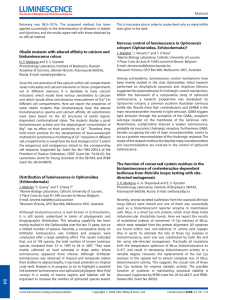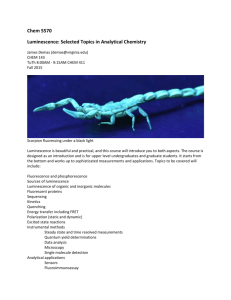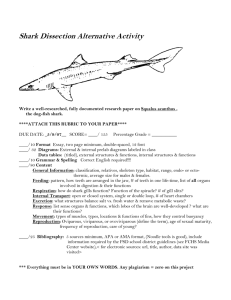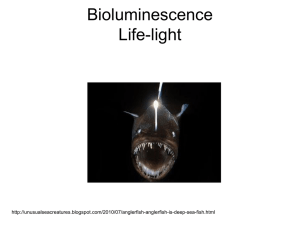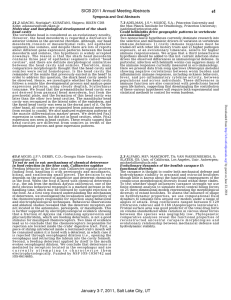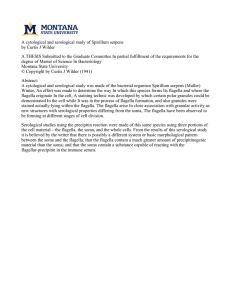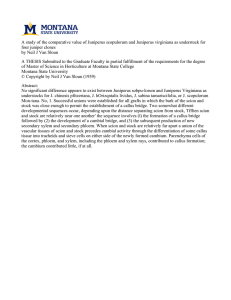LUMINESCENCE
advertisement
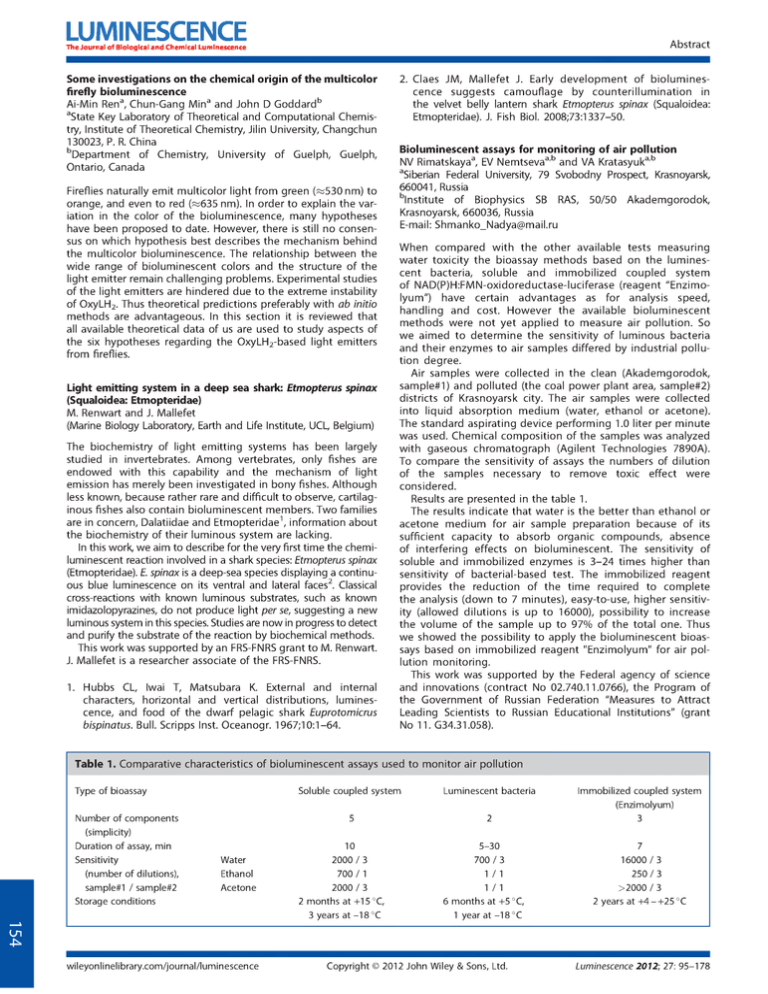
LUMINESCENCE Abstract The Journal o f Biological and Chemical Luminescence Some investigations on the chemical origin of the m ulticolor firefly bioluminescence Ai-Min Rena, Chun-Gang M ina and John D G oddardb aState Key Laboratory o f Theoretical and Computational Chemis­ try, Institute o f Theoretical Chemistry, Jilin University, Changchun 130023, P. R. China bDepartm ent o f Chemistry, University o f Guelph, Guelph, Ontario, Canada Fireflies naturally em it m ulticolo r lig h t from green (æ 530nm) to orange, and even to red (^6 3 5 nm). In order to explain the var­ iation in the color o f the bioluminescence, many hypotheses have been proposed to date. Flowever, there is still no consen­ sus on which hypothesis best describes the mechanism behind the m ulticolo r bioluminescence. The relationship between the w ide range o f biolum inescent colors and the structure o f the light em itter remain challenging problems. Experimental studies o f the light em itters are hindered due to the extrem e instability o f OxyLFl2 . Thus theoretical predictions preferably w ith ab initio methods are advantageous. In this section it is reviewed that all available theoretical data o f us are used to study aspects o f the six hypotheses regarding the OxyLH2-based light em itters from fireflies. Light em itting system in a deep sea shark: Etmopterus spinax (Squaloidea: Etmopteridae) M. Renwart and J. Mallefet (Marine Biology Laboratory, Earth and Life Institute, UCL, Belgium) The biochem istry o f light em ittin g systems has been largely studied in invertebrates. Am ong vertebrates, only fishes are endow ed w ith this capability and the mechanism o f light emission has merely been investigated in bony fishes. Although less known, because rather rare and d ifficu lt to observe, cartilag­ inous fishes also contain biolum inescent members. Two families are in concern, Dalatiidae and E tm opteridae1, inform ation about the biochem istry o f the ir lum inous system are lacking. In this work, we aim to describe for the very first tim e the chemiluminescent reaction involved in a shark species: Etmopterus spinax (Etmopteridae). E. spinax is a deep-sea species displaying a continu­ ous blue luminescence on its ventral and lateral faces2. Classical cross-reactions w ith known luminous substrates, such as known imidazolopyrazines, do not produce light perse, suggesting a new luminous system in this species. Studies are now in progress to detect and purify the substrate o f the reaction by biochemical methods. This w ork was supported by an FRS-FNRS grant to M. Renwart. J. M allefet is a researcher associate o f the FRS-FNRS. 1. Flubbs CL, Iwai T, Matsubara K. External and internal characters, horizontal and vertical distributions, lum ines­ cence, and food o f the dw arf pelagic shark Euprotomicrus bispinatus. Bull. Scripps Inst. Oceanogr. 1967;10:1-64. 2. Claes JM, M allefe t J. Early d e v e lo p m e n t o f b io lu m in e s­ cence suggests cam ouflage by c o u n te rillu m in a tio n in the velvet belly lantern shark Etmopterus spinax (Squaloidea: Etmopteridae). J. Fish Biol. 2008;73:1337-50. Bioluminescent assays for m onitoring o f air pollution NV Rimatskaya3, EV Nemtsevaa,b and VA Kratasyuka,b aSiberian Federal University, 79 Svobodny Prospect, Krasnoyarsk, 660041, Russia blnstitute o f Biophysics SB RAS, 50/50 Akadem gorodok, Krasnoyarsk, 660036, Russia E-mail: Shmanko_Nadya@mail.ru When com pared w ith the o th e r available tests m easuring w a te r to x ic ity the bioassay m ethods based on the lum ines­ cent bacteria, soluble and im m o b ilize d coupled system o f NAD(P)FI:FMN-oxidoreductase-luciferase (reagent "Enzimolyum ") have certain advantages as fo r analysis speed, handling and cost. Flowever the available biolu m in escen t m ethods were not ye t a p plied to measure air po llu tio n . So we aim ed to de te rm in e the sensitivity o f lum inous bacteria and th e ir enzymes to air samples d iffe re d by industrial p o llu ­ tio n degree. Air samples were collected in the clean (Akadem gorodok, sample#1) and po llu ted (the coal pow er plant area, sample#2) districts o f Krasnoyarsk city. The air samples were collected in to liquid absorption m edium (water, ethanol o r acetone). The standard aspirating device perform ing 1.0 lite r per m inute was used. Chemical com p osition o f the samples was analyzed w ith gaseous chrom atograph (A gilent Technologies 7890A). To com pare the sensitivity o f assays the num bers o f d ilu tio n o f the samples necessary to rem ove toxic effect were considered. Results are presented in the table 1. The results indicate th a t w a te r is the be tte r than ethanol or acetone m edium fo r air sample preparation because o f its sufficient capacity to absorb organic com pounds, absence o f in te rfe rin g effects on biolum inescent. The sensitivity o f soluble and im m o bilized enzymes is 3 -2 4 tim es higher than sensitivity o f bacterial-based test. The im m o bilized reagent provides the reduction o f the tim e required to com plete the analysis (dow n to 7 m inutes), easy-to-use, higher sensitiv­ ity (allow ed d ilu tio n s is up to 16000), possibility to increase the volum e o f the sample up to 97% o f the to ta l one. Thus we showed the possibility to apply the biolum inescent bioas­ says based on im m o bilized reagent "Enzim olyum " fo r air po l­ lution m on itorin g. This w o rk was supported by the Federal agency o f science and innovations (contract No 02.740.11.0766), the Program o f the G overnm ent o f Russian Federation "Measures to A ttract Leading Scientists to Russian Educational Institutions" (grant No 11. G34.31.058). Table 1 . Com parative characteristics o f biolum inescent assays used to m on itor air pollution Type o f bioassay Soluble coupled system Luminescent bacteria 5 2 Immobilized coupled system (Enzimolyum) Number o f components 3 (simplicity) Duration o f assay, min Sensitivity Water 10 5-30 7 2000 / 3 7 0 0 /3 1 6 0 0 0 /3 (number o f dilutions), Ethanol 7 0 0 /1 1/ 1 250/3 sample#1 / sample#2 Acetone 2000 / 3 1/ 1 >2000 / 3 Storage conditions 2 months at +15 °C, 3 years at -18°C wileyonlinelibrary.com/journal/luminescence 6 months at +5°C, 2 years at + 4 -+ 2 5 °C 1 year at -18°C Copyright © 2012 John Wiley & Sons, Ltd. Luminescence 2012; 27: 95-178
